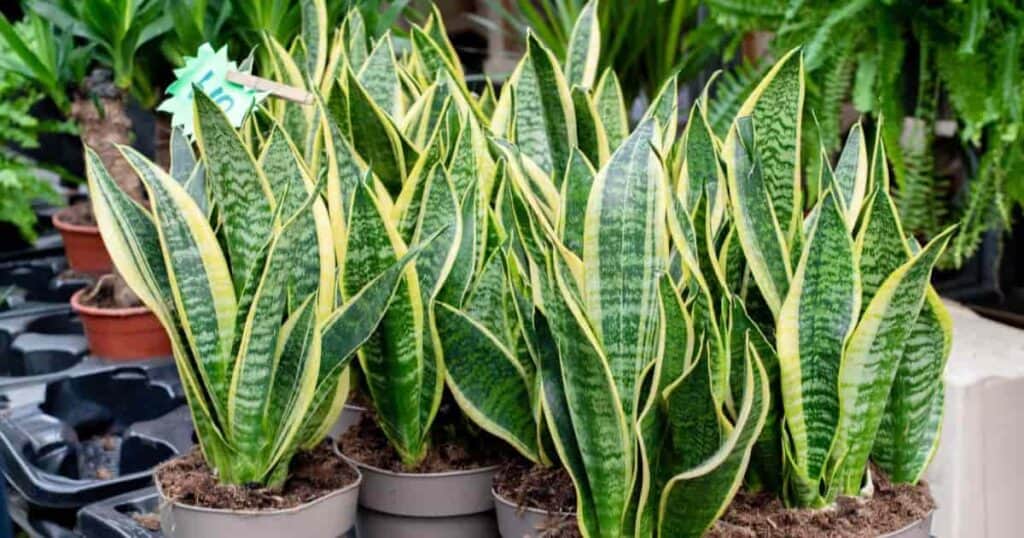Among professional and hobbyist landscapers, many amazing foliage plants can bring a garden together and finish a landscape.
One popular option for outdoor uses, indoor container gardens, and potted plant displays is the Dracaena trifasciata.

Common names you should know:
- Golden Birds Nest
- Good Luck Plant
- Mother-in-law’s Tongue
- Snake Plant
Previously, this plant was known by the scientific name Sansevieria trifasciata.
However, due to changes in nomenclature and classification of the plant family, the name was officially changed around 2017 to the current name Dracaena trifasciata.
This guide is intended to be a good overview of everything you need to know to enjoy success while growing this hardy and unique-looking plant.
Expert advice, insider tips, and practical references are all included here.
So, let’s get started.
General Attributes Of Dracaena Trifasciata:
- Genus: Dracaena
- Species: Trifasciata
- Family: Asparagaceae
- Life Cycle: Perennial
- Country Of Origin: Africa
Basic Dracaena Trifasciata Description
Dracaena Trifasciata is easily recognized due to its unique leaf shape, color, and growth structure.
It is an erect, clumping, broadleaf evergreen houseplant brought over from Africa at some point that has never been accurately determined or pinpointed.
Dracaena trifasciata is well known among plant enthusiasts for being durable, easy to grow, beautiful to look at, and difficult to kill.
It also has become a popular option for homeowners as it is easy to care for and requires very little water and sunlight.
It is highly drought tolerant and thrives in very low light conditions. Well-drained soil and careful watering are necessary to avoid root and leaf rot issues since it largely thrives in areas with lower sun exposure.
The soil should dry out completely from spring to autumn and remain dry for a week or two between waterings.
In contrast, in the cooler winter weather, it only needs watering every 2 to 3 months in many cases.
In regions where the temperature dip below 50° degrees Fahrenheit for long periods, the Dracaena trifasciata need to be covered or brought inside. It should never be allowed to freeze.
It tolerates low humidity and cool temperatures and is pest- and disease-free.
In its native habitat, Dracaena trifasciata blooms in the winter, but as a houseplant, it rarely blooms.
In addition, it was found that some plants can actually remove pollutants from the air during tests conducted by NASA in the 1970s. One of these plants is the Dracaena trifasciata.
Growing these plants in your home can help remove pollutants like formaldehyde, benzene, and ammonia from a room and keep the air you and your family breathe cleaner and safer.
Leaf Description Details
The Dracaena trifasciata is famous for its unique leaves and shape. Stiff, upright, succulent leaves grow in tight clumps or rosettes.
Each thick leaf is flat, can reach a mature height of nearly 4′ feet long, and averages around 2″ to 4″ inches wide.
The rich colors of the plant complement the landscape and houseplant displays, with alternating bands of greens, yellows, and creams traveling the full length of the leaf.
Most varieties have a bright yellow or white band that edges the entire leaf from tip to base.
Growing Conditions To Keep In Mind
- Light: Dracaena trifasciata does best in partial shade and needs less than 5 to 6 hrs of direct sunlight daily to avoid burning the leaves.
- Soil Drainage: Well-draining soil with high organic matter and good air volume are ideal for these plants in the garden or containers.
- USDA Plant Hardiness Zone: Dracaena trifasciata is best suited for outdoor or semi-outdoor areas in zones 10b, 10a, 11b, 11a, 12b, 12a.
Landscape and Gardens
- Landscape Location: Container-grown as a houseplant or in protected areas in outdoor landscapes
- Strengths: Thrives in dry soil and is drought tolerant
- Weaknesses: Prone to over watering issues
- Toxicity: Poisonous to animals such as dogs, cats, and horses, can cause poisoning in children or cause contact dermatitis by handling.
Common Problems With Dracaena Trifasciata
These plants are one of the easiest to maintain and grow and are also usually easy to find.
But to have the best success with Dracaena trifasciata, some warning signs must be watched to maintain the health and vigor of your plant.
Foul-Smelling Soil
If you notice that the soil smells like it’s rotting, it likely has root rot caused by overwatering or no sun exposure at all.
Yellow Or Brown Leaves
In this case, the opposite problem is likely to present- you have not been watering enough, and your Dracaena trifasciata is drying out.
Curling Leaves
Several rare pests, such as thrips and aphids, can cause leaves to curl and bend when they get a foothold and feed off the leaves.
Leaves Falling Over Or Drooping
Leaves that lean and bend or seem limp are usually caused by too much water and not enough sun, showing the plant’s location is not ideal.
Trifasciata is a fascinating plant that has earned its spot in the home gardener’s must-have plant list. With this guide in hand, you will be better prepared to enjoy Dracaena trifasciata for many years and keep it looking amazing in your home or garden.
